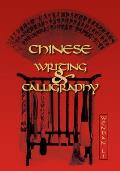Wendan LI teaches at the University of North Carolina. I met her last month at the American Society of Shufa Calligraphy Educators' 8th International Conference on Hanzi Shufa Calligraphy Education at Southwestern University in Georgetown, Texas.
While I was there I heard about her book, Chinese Writing and Calligraphy, and it looked so good I bought a copy. It is an excellent resource both for people who are interested in learning more about calligraphy but don't have a teacher to work with, as well as teachers who would like a textbook suitable for people who don't read Chinese or Japanese.
It has a thorough introduction to the history of Chinese characters, as well as the aesthetic principles behind their construction as artistic forms. Also included are explanations of the tools of calligraphy and finally a large section of practice exercises in standard style 楷書. What's nice about this book is that Professor Li is a specialist in linguistics, so the information she provides is scholarly and reliable. She is also a practicing calligrapher herself, so not only are the illustrations in the historical section very instructive, but the models provided in the practice exercise are so elegant and graceful you just want to copy them. In short, the book is an excellent foundational text for the anglophone classroom.
Wendan Li. Chinese Writing and Calligraphy (Latitude 20 Books). Hawaii: University of Hawai’i Press (2010) ISBN: 0824833643
Teaching and reading classical Japanese literature, especially haiku
Saturday, November 24, 2012
Wednesday, November 14, 2012
Course Syllabuses Re: The 3.11 Disasters
Sophia University in Tokyo has assembled a fantastic list of courses being taught in Japan and the US about the 2011 Great Tohoku Earthquake and Tsunami.
Teaching 3.11 Syllabi Collection
Most are in English or Japanese, though there is a link to one resource in Italian.
Teaching 3.11 Syllabi Collection
Most are in English or Japanese, though there is a link to one resource in Italian.
Labels:
3.11,
public scholarship,
sustainability,
teaching
Saturday, November 10, 2012
Fooling around with fûga 風雅
Some famous phrases associated with fûga (poetry, elegance) from the Bashô school.
There might be some problems with these because I'm taking them out of context. These are more or less notes to myself about their general meaning rather than 100% reliable translations. I'm just thinking about how the Bashô school describes poetic work.
There might be some problems with these because I'm taking them out of context. These are more or less notes to myself about their general meaning rather than 100% reliable translations. I'm just thinking about how the Bashô school describes poetic work.
- 俳諧といへども風雅の一筋なれば姿かたちいやしく作りなすべからず。
Though it be called haikai, it is on a continuum with everything artistic, so you should compose it in a way that is vulgar neither in content nor in form.
- Bashô, cited in Mukai Kyorai's 向井去来 Tabine ron 旅寝論
- 詩・歌・連・俳はともに風雅なり。上三つのものには余す所もあり。その余す所まで俳はいたらずといふ所なし。
Poetry in Chinese, waka, renga, and haikai are all artistic forms of expression. The first three have left areas unexplored. Of those unexplored areas, none may be called unreachable by haikai.Read more >>
- Dohô 土芳, in Sanzôshi 三冊子.
Subscribe to:
Comments (Atom)
